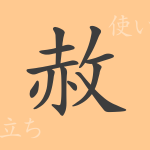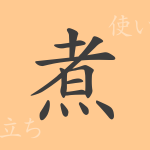The Japanese language is rich with kanji characters, each carrying its own history and meaning. In this article, we focus on the commonly used kanji “斜(しゃ)” and delve into its origins and everyday usage. By understanding the expressive power of this single character, you can rediscover the beauty of the language.
Origins of 斜(しゃ) (Etymology)
The kanji “斜(しゃ)” symbolizes a slanted state or an inclined appearance. In ancient China, it was used to describe buildings or objects that were tilted. The upper part of “斜(しゃ)” is derived from the character “余(よ),” and the lower part is a modified form of “斗(と),” representing something inclined. This is how the character “斜(しゃ)” was formed, evolving over time into its current form.
Meanings and Uses of 斜(しゃ)
The kanji “斜(しゃ)” refers to an angled or tilted state, or something that extends horizontally. Figuratively, it can describe actions that deviate from the norm or unconventional behavior. For example, the expression “斜め上を行く(ななめうえをいく)” means to act in an unpredictable or unexpected way.
Readings, Stroke Count, and Radical of 斜(しゃ)
Let’s take a closer look at the readings, stroke count, and radical of the kanji “斜(しゃ).”
- Readings: The on’yomi (音読み) is “シャ,” and the kun’yomi (訓読み) is “ななめ.”
- Stroke count: It consists of 11 strokes.
- Radical: The radical is “斗(と).”
Idioms, Phrases, and Proverbs Using 斜(しゃ)
There are many idioms, phrases, and proverbs in Japanese that include the kanji “斜(しゃ).” Here are a few examples:
- 「斜陽(しゃよう)」: Refers to a declining state.
- 「斜面(しゃめん)」: Indicates a sloped surface.
- 「斜視(しゃし)」: Describes a condition where the eyes do not align correctly.
- 「斜めに構える(ななめにかまえる)」: Means to take a skeptical or detached stance.
Conclusion on 斜(しゃ)
The kanji “斜(しゃ)” is used in a variety of expressions in Japanese, from describing a literal slant to metaphorical meanings. Its rich form and meaning demonstrate the versatility of this character in the language. You will frequently encounter this kanji in daily life, and with the knowledge from this article, you can better understand the meanings behind the words you read and hear.

























